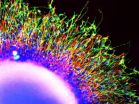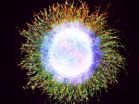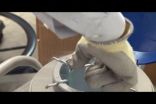(Press-News.org) LA JOLLA—Using new stem cell technology, scientists at the Salk Institute have shown that neurons generated from the skin cells of people with schizophrenia behave strangely in early developmental stages, providing a hint as to ways to detect and potentially treat the disease early.
The findings of the study, published online in April's Molecular Psychiatry, support the theory that the neurological dysfunction that eventually causes schizophrenia may begin in the brains of babies still in the womb.
"This study aims to investigate the earliest detectable changes in the brain that lead to schizophrenia," says Fred H. Gage, Salk professor of genetics. "We were surprised at how early in the developmental process that defects in neural function could be detected."
Currently, over 1.1 percent of the world's population has schizophrenia, with an estimated three million cases in the United States alone. The economic cost is high: in 2002, Americans spent nearly $63 billion on treatment and managing disability. The emotional cost is higher still: 10 percent of those with schizophrenia are driven to commit suicide by the burden of coping with the disease.
Although schizophrenia is a devastating disease, scientists still know very little about its underlying causes, and it is still unknown which cells in the brain are affected and how. Previously, scientists had only been able to study schizophrenia by examining the brains of patients after death, but age, stress, medication or drug abuse had often altered or damaged the brains of these patients, making it difficult to pinpoint the disease's origins.
The Salk scientists were able to avoid this hurdle by using stem cell technologies. They took skin cells from patients, coaxed the cells to revert back to an earlier stem cell form and then prompted them to grow into very early-stage neurons (dubbed neural progenitor cells or NPCs). These NPCs are similar to the cells in the brain of a developing fetus.
The researchers generated NPCs from the skin cells of four patients with schizophrenia and six people without the disease. They tested the cells in two types of assays: in one test, they looked at how far the cells moved and interacted with particular surfaces; in the other test, they looked at stress in the cells by imaging mitochondria, which are tiny organelles that generate energy for the cells.
On both tests, the Salk team found that NPCs from people with schizophrenia differed in significant ways from those taken from unaffected people.
In particular, cells predisposed to schizophrenia showed unusual activity in two major classes of proteins: those involved in adhesion and connectivity, and those involved in oxidative stress. Neural cells from patients with schizophrenia tended to have aberrant migration (which may result in the poor connectivity seen later in the brain) and increased levels of oxidative stress (which can lead to cell death).
These findings are consistent with a prevailing theory that events occurring during pregnancy can contribute to schizophrenia, even though the disease doesn't manifest until early adulthood. Past studies suggest that mothers who experience infection, malnutrition or extreme stress during pregnancy are at a higher risk of having children with schizophrenia. The reason for this is unknown, but both genetic and environmental factors likely play a role.
"The study hints that there may be opportunities to create diagnostic tests for schizophrenia at an early stage," says Gage, who holds the Vi and John Adler Chair for Research on Age-Related Neurodegenerative Disease.
Kristen Brennand, the first author of the paper and assistant professor at Icahn School of Medicine at Mount Sinai, said the researchers were surprised that the skin-derived neurons remained in such an early stage of development. "We realized they weren't mature neurons but only as old as neurons in the first trimester," Brennand says. "So we weren't studying schizophrenia but the things that go wrong a long time before patients actually get sick."
Interestingly, the study also found that antipsychotic medication such as clozapine and loxapine did not improve migration in NPCs (in particular, loxapine actually worsened migration in these cells).
"That was an experiment that gave the opposite results from what we were expecting," says Brennand. "Though in hindsight, using drugs that treat symptoms might not be helpful in trying to prevent the disease."
The next steps to this work will be to increase the sample size to a broader range of patients and to look at hundreds or thousands of patient samples, says Brennand.
INFORMATION:
Contributors to this work include Yongsung Kim, Ngoc Tran, Anthony Simone, Hyung Joon Kim, and Ian Ladran at the Salk Institute; Jeffrey Savas and John Yates at the Scripps Research Institute; Kazue Hashimoto-Torii and Pasko Rakic at Yale University; Kristin Beaumont and Milan Mrksich at Northwestern University; Aaron Topol, Mohammed Abdelrahim, Bridget Matikainen-Ankne, Gang Fang and Bin Zhang at Icahn School of Medicine at Mount Sinai; and Shih-hui Chao at Arizona State University Tempe.
The Gage Laboratory is partially funded by the California Institute of Regenerative Medicine (CIRM), the G Harold & Leila Y Mathers Foundation, the JPB Foundation, the Leona M and Harry B Helmsley Charitable Trust, Annette Merle-Smith, and Robert and Mary Jane Engman. The Brennand Laboratory is partially funded by NARSAD, NIMH and the New York Stem Cell Foundation.
About the Salk Institute for Biological Studies:
The Salk Institute for Biological Studies is one of the world's preeminent basic research institutions, where internationally renowned faculty probes fundamental life science questions in a unique, collaborative, and creative environment. Focused both on discovery and on mentoring future generations of researchers, Salk scientists make groundbreaking contributions to our understanding of cancer, aging, Alzheimer's, diabetes and infectious diseases by studying neuroscience, genetics, cell and plant biology, and related disciplines.
Faculty achievements have been recognized with numerous honors, including Nobel Prizes and memberships in the National Academy of Sciences. Founded in 1960 by polio vaccine pioneer Jonas Salk, M.D., the Institute is an independent nonprofit organization and architectural landmark.
New stem cell research points to early indicators of schizophrenia
Salk scientists show fundamental differences in early neurons from patients with schizophrenia, supporting the theory that risk for the disease may begin in the womb
2014-05-13
ELSE PRESS RELEASES FROM THIS DATE:
Preschool teacher depression linked to behavioral problems in children
2014-05-13
COLUMBUS, Ohio – Depression in preschool teachers is associated with behavioral problems ranging from aggression to sadness in children under the teachers' care, new research suggests.
The study identified one contributing factor to this link: a poor-quality atmosphere in the child care setting that exists as a result of the teacher's depressive symptoms. In this study, "teacher" refers to both classroom instructors and in-home child care providers.
Researchers conducted the study using data from a large national study that collected family information primarily from ...
Odd planet, so far from its star...
2014-05-13
This news release is available in French.
A gas giant has been added to the short list of exoplanets discovered through direct imaging. It is located around GU Psc, a star three times less massive than the Sun and located in the constellation Pisces. The international research team, led by Marie-Ève Naud, a PhD student in the Department of Physics at the Université de Montréal, was able to find this planet by combining observations from the the Gemini Observatories, the Observatoire Mont-Mégantic (OMM), the Canada-France-Hawaii Telescope (CFHT) and the W.M. Keck Observatory.
A ...
Autophagic activation with Nimotuzumab enhances chemo-radiosensitivity
2014-05-13
A study which will be published in the May 2014 issue of Experimental Biology and Medicine was aimed at determining whether an EGFR-targeted therapy combined with chemo-radiotherapy can improve local tumor control effectively, compared to cytotoxic agents or irradiation alone. Dr. Haizhu Song and co-workers from Jinling Hospital and the Medical School of Nanjing University in China demonstrated that nimotuzumab could enhance chemo-radiosensitivity by promoting autophagic cell death in esophageal squamous carcinoma (ESCC) cells.
Nimotuzumab is a humanized anti-EGFR monoclonal ...
Distance influences accuracy of eyewitness IDs
2014-05-13
Eyewitness accuracy declines steadily and quite measuredly as the distance increases. Additionally, a good deal of guess work or so-called "false alarms" also comes into play as the distance increases. These findings have implications for the trustworthiness of eyewitness accounts that are used to solve criminal cases. Research led by James Lampinen of the University of Arkansas in the US and published in Springer's journal Psychonomic Bulletin & Review sheds light on the matter.
Eyewitness identification plays a crucial role in approximately 80,000 criminal cases per ...
Follow that fish!
2014-05-13
New findings published by researchers at the New York University Polytechnic School of Engineering are helping to unravel the complex interplay between alcohol and social behavior and may lead to new therapies for mitigating the negative impacts of alcohol use and abuse. Their experiments, published in the current issue of Alcohol: Clinical and Experimental Research, center not on patrons at a local happy hour, but on far simpler creatures: zebrafish.
A team led by Maurizio Porfiri, associate professor of mechanical and aerospace engineering and director of the school's ...
3-D 'map' of enzyme completed by MU scientists could lead to more effective drugs
2014-05-13
COLUMBIA, Mo. – The human body is full of proteins called enzymes that help nearly every function in the body. Scientists have been studying enzymes for decades in order to learn how they work and how to create better drugs and medical treatments for many ailments. Now, University of Missouri researchers have completed a 3-D map of an enzyme called Proline utilization A (PutA). PutA facilitates metabolism by adding oxygen to molecules. John Tanner, a professor in the MU Department of Biochemistry, says mapping this enzyme will give researchers a better understanding of ...
Achieving patient-centered care across the spectrum
2014-05-13
HANOVER, NH – Providing patient-centered care consistently in clinical practice requires practitioners who are able to recognize that different clinical situations require different approaches and are skilled enough to adapt.
Across the range of health-care problems, patient-centered care has been found to be associated with improved patient outcomes, including improved self-management, patient satisfaction, and medication adherence, and some studies have found evidence for improved clinical outcomes. Data from surveys and research indicate that clinicians often do not ...
Obsessive-compulsive disorder questionnaire may give clues to other mental health problems
2014-05-13
A shortened version of a questionnaire used by psychologists to assess risk factors for obsessive-compulsive disorder also may help determine the risk of depression and anxiety, according to a Baylor University study.
The revision may be a good fit for assessing the risk of mental health issues stemming from certain beliefs — such as seeing threats as greater than they are and feeling that things are not right unless they are perfect. Such dysfunctional beliefs are central to obsessive-compulsive disorder (OCD), said researcher Thomas Fergus, Ph.D., assistant professor ...
Women's empowerment and Olympic success
2014-05-13
ALLENDALE, Mich. — New research shows that nations with greater women's empowerment win more medals and send more athletes to the Summer Olympics. The effect of women's empowerment held for both men and women, although it was stronger for female athletes, according to a study by Grand Valley State University researchers. The findings were published in April 2014 in the Journal of Sports Economics.
The research, led by Aaron Lowen, associate professor of economics at Grand Valley State, provides evidence for the popular but previously untested hypothesis that women's empowerment ...
Fossil palm beetles 'hind-cast' 50-million-year-old winters
2014-05-13
Fifty-million-year-old fossil beetles that fed only on palm seeds are giving Simon Fraser University biologists Bruce Archibald and Rolf Mathewes new information about ancient climates.
According to their research, published online this week in The Proceedings of the National Academy of Sciences, these fossil beetles indicate that during a period of global warming in the geological past, there were mild, frost-free winters extended even in the uplands of ancient western North America.
Working with co-authors Geoffrey Morse of the University of San Diego, California, ...
LAST 30 PRESS RELEASES:
The Ceramic Society of Japan’s Oxoate Ceramics Research Association launches new international book project
Heart-brain connection: international study reveals the role of the vagus nerve in keeping the heart young
Researchers identify Rb1 as a predictive biomarker for a new therapeutic strategy in some breast cancers
Survey reveals ethical gaps slowing AI adoption in pediatric surgery
Stimulant ADHD medications work differently than thought
AI overestimates how smart people are, according to HSE economists
HSE researchers create genome-wide map of quadruplexes
Scientists boost cell "powerhouses" to burn more calories
Automatic label checking: The missing step in making reliable medical AI
Low daily alcohol intake linked to 50% heightened mouth cancer risk in India
American Meteorological Society announces Rick Spinrad as 2026 President-Elect
Biomass-based carbon capture spotlighted in newly released global climate webinar recording
Illuminating invisible nano pollutants: advanced bioimaging tracks the full journey of emerging nanoscale contaminants in living systems
How does age affect recovery from spinal cord injury?
Novel AI tool offers prognosis for patients with head and neck cancer
Fathers’ microplastic exposure tied to their children’s metabolic problems
Research validates laboratory model for studying high-grade serous ovarian cancer
SIR 2026 delivers transformative breakthroughs in minimally invasive medicine to improve patient care
Stem Cell Reports most downloaded papers of 2025 highlight the breadth and impact of stem cell research
Oxford-led study estimates NHS spends around 3% of its primary and secondary care budget on the health impacts of heat and cold in England
A researcher’s long quest leads to a smart composite breakthrough
Urban wild bees act as “microbial sensors” of city health.
New study finds where you live affects recovery after a hip fracture
Forecasting the impact of fully automated vehicle adoption on US road traffic injuries
Alcohol-related hospitalizations from 2016 to 2022
Semaglutide and hospitalizations in patients with obesity and established cardiovascular disease
Researchers ‘listen in’ to embryo-mother interactions during implantation using a culture system replicating the womb lining
How changing your diet could help save the world
How to make AI truly scalable and reliable for real-time traffic assignment?
Beyond fragmented markets: A new framework for efficient and stable ride-pooling
[Press-News.org] New stem cell research points to early indicators of schizophreniaSalk scientists show fundamental differences in early neurons from patients with schizophrenia, supporting the theory that risk for the disease may begin in the womb





